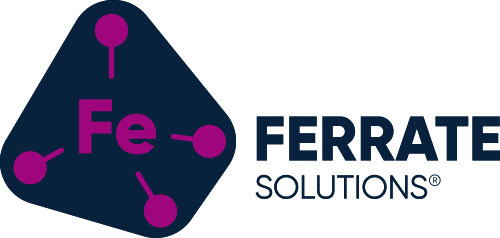Radionuclides in Drinking Water; A Market for Ferrate?
– Dr. Tom Waite, Founder, Ferrate Solutions
Most of the radionuclides present in drinking water supplies are from natural sources. Naturally occurring radionuclides are created in the upper atmosphere and are bound in the Earth’s crust. They are found in certain types of rocks that contain trace amounts of the radioactive isotopes of uranium, thorium and/or actinium. As these rocks weather, the resulting clays and other materials may transmit radionuclides into water supplies.
Over time, radionuclides decay. As they decay, they produce daughter products that are shorter lived, and more radioactive. Of particular concern are the naturally occurring compounds; uranium and radium, which can accumulate to harmful levels in water supplies. As radionuclides decay, they emit radiation: {alpha particles, beta particles and gamma rays}. Each type of radiation produces different effects on humans.
Maximum Contaminant Levels (MCL) in drinking water have been established in the US by the EPA for a variety of radionuclides. For radium, the MCL has been set at 5 pCi/L (picocuries per liter), a unit of measure for levels of radiation. The MCL for gross alpha radiation (sum of all alpha emitting radionuclides) is 15 pCi/L, and the MCL for gross beta radiation is 50 pCi/L.
Radionuclide contamination in groundwater is common in the US, especially in deep aquifers in the southwest. For example, a survey of groundwater wells in Texas found that over 3,800 contained detectable amounts of gross alpha radiation. Of those, about 10 percent contained gross alpha radiation above the MCL of 15 pCi/L. In addition, high levels of gross alpha radioactivity (over the MCL) were found in 22 of the 31 major aquifers in Texas. This is an obvious concern for drinking water supplies, and more recently, disposal of contaminated “blow-back” water from oil & gas fracking operations.
Treatment of Radionuclide Contaminated Water and Management of Radioactive Residuals.
The USEPA lists Best Available Technologies (BATs) for radionuclide treatment, (A Regulators’ Guide to the Management of Radioactive Residuals from Drinking Water Treatment Technologies (EPA 816-R-05-004, July 2005) and it is important to note that use of a BAT is not required. Any technology that is accepted by the Primacy Agency and achieves compliance with the MCL is allowed. If a non-radionuclide contaminated water supply is available, it can be “blended” with the contaminated water to dilute the radionuclides below the regulatory MCL. In this case no radioactive “treatment residuals” would be generated.
TREATMENT- Any treatment technology utilized to remove radionuclides from water will produce residuals of some form. These residuals will need to be disposed in accordance with strict (and expensive!) regulatory guidelines {see below}. Therefore, it is extremely important to select a treatment process that will produce a minimum amount of radioactive residual, and it is extremely advantageous to have this residual in a dry form that can be easily containerized. Treatment processes utilizing absorption or ion exchange will generate large expensive! volumes of contaminated bed material. Membrane systems (reverse osmosis) will generate large volumes of concentrated liquid waste streams which will require collection and storage, and also generate significant transport challenges. Processes that will generate the minimum amount of radioactive residual will be chemical precipitation systems. However, the challenge with these systems is to develop a chemistry such that high levels of radionuclide removal are achieved (precipitation) while producing a minimal, easily dewatered, non-toxic precipitate (sludge). Chemical treatment systems utilizing lime produce excessive amounts of sludge, and this material is extremely difficult to dewater. The use of common coagulants (ferric iron and aluminum-based compounds) has not shown consistent results of effective radionuclide removal, and aluminum precipitates are difficult to dewater and are toxic to the environment. {Hint} .… high-valence iron (FeO42-) is the answer ….
DISPOSAL of RESIDUALS- The residuals from treating water containing radionuclides will contain high levels of radiation. These residual streams are called Technically Enhanced Naturally Occurring Radioactive Materials (TENORM). This implies that the high radionuclide concentrations in these residuals have the potential to cause human and environmental harm, and that this high concentration of radioactivity is a result of human activities. The concentration of TENORM in these residuals, and the type of waste (liquid or solid) will affect what disposal options are available. Licenses for disposal may be required from the Nuclear Regulatory Commission (NRC) if the residuals contain uranium or thorium at high concentrations. Other licenses may be required by the Agreement State depending on the concentrations of various radionuclides in the residuals. If other toxic, non-radioactive materials are also present in the residual (mixed waste) it may be classified as a Hazardous Waste and fall under the regulations of the Resource Conservation and Recovery Act (RCRA).
The disposal options for TENORM residuals vary significantly due to numerous State and local regulations governing waste streams containing radionuclides. While there are no federal waste disposal regulations specifically for TENORM residuals, Primacy Agencies and regional disposal facilities can impose additional restrictions on disposal options. It is clear that the biggest challenge to the treatment of radionuclides in water is the expensive! and problematic challenges associated with ultimate disposal of TENORM residuals. It is therefore clear that careful selection of a treatment process, focusing on minimal formation of TENORM is imperative. Ferrate (FeO42-) has been shown to be an extremely effective co- precipitator for all forms of radionuclides, and because the amount of iron added during treatment is minimal, TENORM residual formation is minimal. In addition to the minimum amount of sludge formation, the ferric hydroxide generated from ferrate reactions is easily dewatered, collected, and containerized for easy transport and disposal

0 Comments